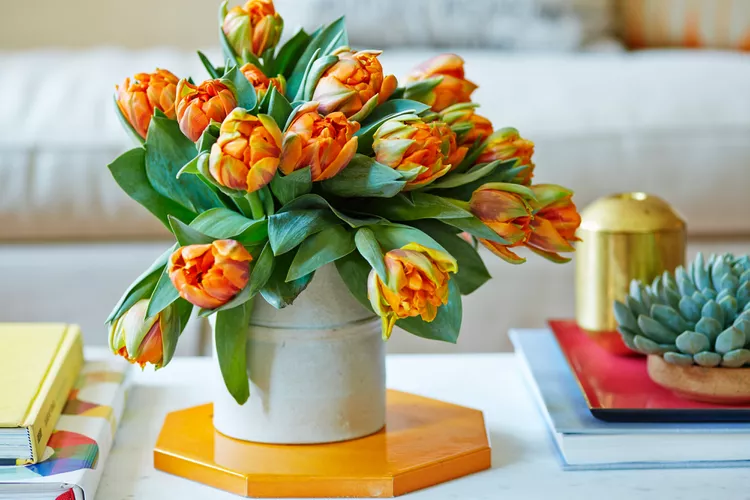Knowing exactly how and when to cut tulips from your garden to display indoors will help you get the most out of these colorful spring flowers. When properly cut and cared for, garden-fresh tulips will reward you by showing off their pretty petals for a week to 10 days. In fact, the stems even keep growing (up to an inch per day!) after being cut. Help your fresh-cut tulips last as long as possible with these four must-know tips and tricks from floral experts nationwide.
1. Cut Tulips at the Right Stage
To make your tulips last longest, cut the blooms when they have about 50%-75% of their full color. Any less, and the flowers won't develop further in a vase. "If you cut them too early, while they're still completely green and tight, they might never get their color," says Beth Barnett of Larkspur Flowers and Design in Chicago, Illinois.
On the flip side, Barnett also cautions against waiting too long. "In the springtime, once it starts getting warmer and sunnier out, you want to be careful to not let [tulips] get going too much because they won't last as long." And like most flowers you want to cut, aim to harvest them either early in the morning or later in the evening when temperatures tend to be coolest.
2. Take Time to Prep Stems
When you bring your tulips inside, use clean clippers to give them a fresh cut before wrapping the stems in newspaper or brown craft paper to keep them straight. Also, strip off any browning lower leaves so they won't rot in the vase water. The bacteria in the dirty water can cause the flower stems to become mushy.
"The more stuff you have in [the vase], the faster the water is going to get dirty. So take off any of those old leaves or bottom leaves that are on there," says floral designer Ellen Frost of Local Color Flowers in Baltimore, Maryland. "You want your flower to hydrate, and you really don't need ugly lower leaves to get hydrated. You want all of that water to put energy into the bloom itself."
Leave the wrapped tulips in a tall vase with just a couple of inches of cool water for 12-18 hours before arranging them. This will help prevent the stems from becoming soft and slimy.
3. Keep Things Clean
To help your flowers last for up to a week or so in a vase, make sure you first clean your vessel and your flower frog (if you want extra support in your arrangement) with a bit of bleach and water to disinfect the surfaces of any bacteria. Then, give the stems another trim with clean clippers before placing them in fresh water. Change the water daily and trim the stem ends each time you do.
4. Use Flower Food
Add a little bit of flower food (Crysal or FloraLife packets, for example) each time you change the water. You only need to use a small portion at first. After a couple of days, when you change the water and give the stems a fresh cut, add a little more of your flower food to the vase.
“Flower food is always going to increase the longevity of any flower,” says Niki Irving of Flourish Flower Farm in Asheville, North Carolina. “You really only need to use a third or a half [of the packet] at a time, you don't have to put the whole thing in your vase in one go.”
Best Tulips to Grow for Cutting
Irving, Barnett, and Frost shared their favorite tulip varieties to grow for cutting, which include single, double, and parrot tulips. They also suggest planting a selection of types with early, mid, and late bloom times to maximize the period you'll have tulips in your garden to harvest. Some of their favorites include:
'Angelique' For a late bloom and frilly pink flowers
'Apricot' A parrot variety that features sunset hues on ruffled petals
'Brown Sugar' An especially fragrant type that boasts mauve-colored blooms
'Copper Image' A coppery-salmon colored double tulip
'Foxtrot' An early-blooming pink double that looks almost like a peony
'Menton' A tall, peachy-striped coral variety
'Negrita' A plum-colored parrot tulip on a sturdy stem
'Super Parrot' White scalloped petals are interestingly streaked with green
'Silver Parrot' Dark pink flowers top variegated foliage




















